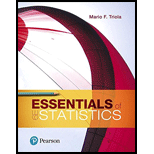
In Exercises 5–20, assume that the two samples are independent simple random samples selected from
18. Car and Taxi Ages When the author visited Dublin. Ireland (home of Guinness Brewery employee William Gosset, who first developed the t distribution), he recorded the ages of randomly selected passenger cars and randomly selected taxis. The ages can be found from the license plates. (There is no end to the fun of traveling with the author.) The ages (in years) are listed below. We might expect that taxis would be newer, so test the claim that the

Want to see the full answer?
Check out a sample textbook solution
Chapter 9 Solutions
Essentials of Statistics (6th Edition)
- In Exercises 13–20, determine whether the data are from a discrete or continuous data set. CHIS Among the subjects surveyed as part of the California Health Interview Survey (CHIS), several subjects are randomly selected and their heights are recorded.arrow_forwardA relationship expert wants to know if people with higher levels of emotionalintelligence (measured on an interval scale from 1–6, with higher numbers meaning more intelligence) will be better liked upon first meeting people (measured on a 1–5 interval scale, with higher numbers meaning more likable). X: Emotional Intelligence Score Y: First Impression Rating 6 4.5 2.5 3.2 3 3 1 2 M=3.13s=2.10SS = 13.19 M=3.18s=1.03SS = 3.17 c) Report results in APA style.d) What do the results mean?arrow_forwardA relationship expert wants to know if people with higher levels of emotionalintelligence (measured on an interval scale from 1–6, with higher numbers meaning more intelligence) will be better liked upon first meeting people (measured on a 1–5 interval scale, with higher numbers meaning more likable). X: Emotional Intelligence Score Y: First Impression Rating 6 4.5 3 3.2 2.5 3 1 2 M=3.13s=2.10SS = 13.19 M=3.18s=1.03SS = 3.17 a) Create a scatterplot of the data.b) Calculate r and r2 .c) Report results in APA style.d) What do the results mean?arrow_forward
- pls. answer using 7 steps:-Parameter of interest-Null hypothesisAlternative hypothesis -Test statistic -Reject H0 if: -Computations: -Conclusionarrow_forwardA clinical psychologist is interested in the relationship between testosterone level in married males and the quality of their marital relationship. A study is conducted in which the testosterone levels of eight married men are measured. The eight men also fill out a standardized questionnaire assessing quality of marital relationship. The questionnaire scale is 0–25, with higher numbers indicating better relationships. Testosterone scores are in nanomoles/liter of serum. The data are shown below. Subject Number 1 2 3 4 5 6 7 8 Relationship Score 24 15 15 10 19 11 20 19 Testosterone Level 12 13 19 25 M 16 15 21 a. Determine the least-squares regression line for predicting relationship score from testosterone level. b. What percentage of the variance in relationship score is accounted for by the regression equation? c. Can we conclude that there is a significant relationship between the testosterone level…arrow_forwardRefer to the data presented in Exercise 2.86. Note that there were 50% more accidents in the 25 to less than 30 age group than in the 20 to less than 25 age group. Does this suggest that the older group of drivers in this city is more accident- prone than the younger group? What other explanation might account for the difference in accident rates?arrow_forward
- A. Find: Solve each number by substituting the value form the given table below. 1 X P(x) 0 1/5 1 2/5 3 1/5 1/5 1. P(3) 2. P(1) + P(4) 3. P(2) x P (3) 4. P(4) + P(2) 5. P(2) + P(3) B. Determine the Mean, Variance and Standard Deviation of each random variable. 1. y 0 1 2 3 4 P(y) 1/5 1/5 1/5 1/5 1/5 5. 2. 3. 4. Y P(y) Z P(z) S P(s) r P(r) 3 0.6 3 0.1 1 1/2 5 0.1 10 3/7 4 0.5 2 1/6 7 0.2 12 0.2 20 4/7 3 1/3 9 0.1 20 0.2arrow_forwardA manufacturer knows that their items lifespans are normally distributed according to N(5.1,1.5)N(5.1,1.5).What proportion of the items' lifespans will be longer than 6 years?arrow_forwardFind the z score for test scores of 70 _____ and 90 ______.arrow_forward
- If z, and x be 2 values of a variable x and each of the remaining (n – 2) values be +%), find the mean and standard deviation of the n values.arrow_forwardSuppose that 95% of the bags of certain fertilizer mix weigh between 49 and 53 pounds. Averages of three succesive bags were plotted, and 47.5% of these were observed to lie between 51 and X pounds. Estimate the value of X. State assumptions you make and say whether these assumptions are likely to be true for this example.arrow_forwardPlease do iv. Calculate the variance onlyarrow_forward
 MATLAB: An Introduction with ApplicationsStatisticsISBN:9781119256830Author:Amos GilatPublisher:John Wiley & Sons Inc
MATLAB: An Introduction with ApplicationsStatisticsISBN:9781119256830Author:Amos GilatPublisher:John Wiley & Sons Inc Probability and Statistics for Engineering and th...StatisticsISBN:9781305251809Author:Jay L. DevorePublisher:Cengage Learning
Probability and Statistics for Engineering and th...StatisticsISBN:9781305251809Author:Jay L. DevorePublisher:Cengage Learning Statistics for The Behavioral Sciences (MindTap C...StatisticsISBN:9781305504912Author:Frederick J Gravetter, Larry B. WallnauPublisher:Cengage Learning
Statistics for The Behavioral Sciences (MindTap C...StatisticsISBN:9781305504912Author:Frederick J Gravetter, Larry B. WallnauPublisher:Cengage Learning Elementary Statistics: Picturing the World (7th E...StatisticsISBN:9780134683416Author:Ron Larson, Betsy FarberPublisher:PEARSON
Elementary Statistics: Picturing the World (7th E...StatisticsISBN:9780134683416Author:Ron Larson, Betsy FarberPublisher:PEARSON The Basic Practice of StatisticsStatisticsISBN:9781319042578Author:David S. Moore, William I. Notz, Michael A. FlignerPublisher:W. H. Freeman
The Basic Practice of StatisticsStatisticsISBN:9781319042578Author:David S. Moore, William I. Notz, Michael A. FlignerPublisher:W. H. Freeman Introduction to the Practice of StatisticsStatisticsISBN:9781319013387Author:David S. Moore, George P. McCabe, Bruce A. CraigPublisher:W. H. Freeman
Introduction to the Practice of StatisticsStatisticsISBN:9781319013387Author:David S. Moore, George P. McCabe, Bruce A. CraigPublisher:W. H. Freeman





